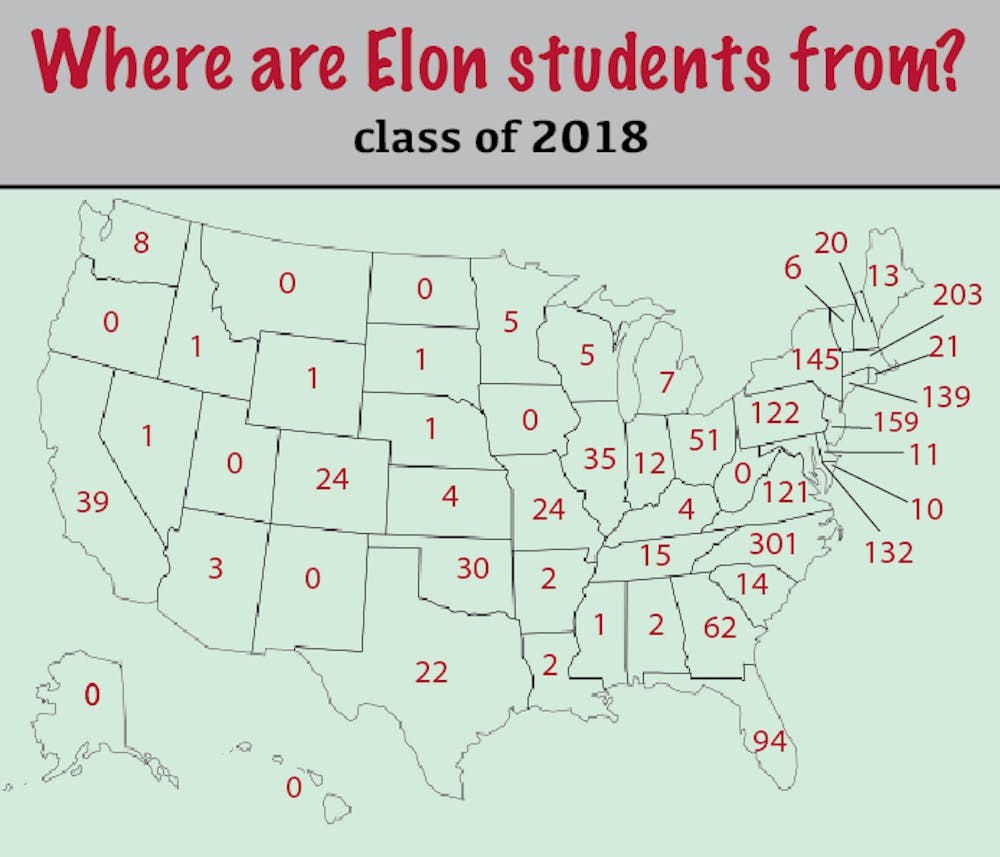An increasing student body and recent plans for the construction of multiple buildings in the last few years all point to Elon University’s growth, evidence Elon is attempting to become a more diverse campus nationally, internationally and culturally.
Currently, students from every state except for North Dakota are represented in the student body. That will change next fall as an incoming freshman from North Dakota will join the Elon community.
Even so, there are obvious demographic trends in the composition of Elon students. According to the 2014-2015 Elon Fact Book, Elon is primarily composed of students from North Carolina, Massachusetts, New Jersey, Maryland and Virginia.
Elon’s admissions process provides some explanation. Based on demographic data, Elon focuses recruitment efforts to areas that have been successful in the past, while also evaluating areas that could be potential outlets for increased recruitment efforts.
“We evaluate trending demographics and external and internal data to determine emerging markets for Elon,” said Lisa Keegan, dean of admissions.
Susan Klopman, former vice president of admissions and financial planning at Elon, explained that geographic areas of past successful recruiting helps Elon concentrate its efforts and establish Elon’s name in various regions.“In those communities and schools Elon has built a reputation through the students and families who are currently enrolled or are graduates of Elon,” Klopman said. “They are the living proof of the veracity and accuracy of our messages.”
Recently, there has been a push to increase recruitment efforts on the West Coast, specifically California.
“Our efforts of adding a regional representative in California and seeing an increase in enrolling students from California demonstrates that our presence in emerging markets is key to our recruitment success,” Keegan said.
Klopman explained that recruiting in California was successful because many private high schools were searching for “new” East Coast schools for students, coupled with the reputation of Elon’s musical theatre and communications programs.California served as a prime example of Elon’s recruitment strategy, according to Klopman.
“So we repeat this pattern of recruiting—revisiting and expanding our territory,” Klopman said.
Sophomore Shay Hopkins-Paine, from Maine, said Elon is appealing to people from regions like the Northeast and the West Coast.
“It’s not so southern that people are out of their comfort zone,” Hopkins-Paine said.
Keegan believes part of what makes Elon so appealing to students from the Northeast is the value of the education, coupled with the cost of Elon in comparison to private universities in the Northeast.
“We recruit heavily in the Northeast and have tremendous support from alumni and parents in that region,” Keegan said. “Those are both critical to our recruitment efforts.”
Even so, pockets of the United States are unfamiliar with Elon. Hopkins-Paine heard of Elon through her best friend from home, who is a year older and had already made the choice to attend Elon.
“I had never heard of Elon except for through my friend,” Hopkins-Paine said. “There were no recruitment efforts [in Maine].”
Freshman Erin Donnelly from Minnesota heard of Elon through her high school guidance counselor. She is one of five freshman students from Minnesota. Visiting Elon, though, was what sealed the deal for her.
“My family decided to take a trip to come visit the school, and it just felt right and felt like home when I walked on campus,” Donnelly said.
Hopkins-Paine thinks recruitment efforts to different parts of the United States would not have to be extreme but could familiarize people with Elon’s name.
“I would just love little things [changed],” Hopkins-Paine said. “Going to college fairs in Maine would be incredible. Going to college fairs in every state would be incredible. It would be really great if Elon put their name out there more.”
Hopkins-Paine and Donnelly said Elon is more diverse than their home states, and it has been interesting for them to become acquainted with a variety of people. Hopkins-Paine believes Elon is truly making an effort to increase diversity on campus and both students agree there is no prominent geographic or regional culture present on campus.
“I honestly was surprised at how diverse Elon is,” Donnelly said. “I have met so many people from all over the country and don’t feel that there is a distinct culture, other than everyone being super involved in multiple things.”
During Klopman’s 27-year long career at Elon, the demographics of the student body certainly shifted. In particular, she noted that the number of Hispanic applicants significantly increased during the course of her career.Elon’s admissions team will continue to use various data tools to track territory management during recruitment efforts to expand Elon’s demographic composition.
An admissions counselor was recently hired to target high school students in Illinois, based on the data indicating that Illinois is an area where students are increasingly interested in Elon.
Furthermore, Texas has been identified as state with potential and more recruitment efforts will be concentrated there next year.
“I hope we will continue to see rich geographic diversity among Elon students, both domestically and internationally,” said Keegan. “I think we will see increasing students from the Great Lakes and West Coast and hope that we continue to draw students from new and emerging markets for Elon.”
In addition to geographic diversity, Klopman hopes that intellectual and religious diversity continues to increase at Elon.
“I hope we have students who introduce interests that push us to new majors, especially in the STEM areas,” Klopman said. “I hope religious diversity will be so great that we begin here a dialogue that extends far beyond our campus into the communities where our graduates live and work and make the world a more inclusive, caring place.”


